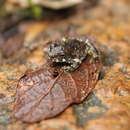ar
الأسماء في صفحات التنقل


The canyon tree frog (Dryophytes arenicolor) is a species of tree frog native to the rocky plateau areas of southern United States, primarily in New Mexico and Arizona, but it also ranges to Utah, Texas, and Colorado, and as far south as the Mexican states of Michoacán, México, Guanajuato, Guerrero, and Oaxaca.[2]
Canyon tree frogs grow to 5.0–5.5 cm (2.0–2.2 in) in length, and are typically brown, grey-brown, or grey-green in color, often with darker-colored blotching. They can vary considerably, but usually match the soil or rock coloration of their native habitats to serve as camouflage. Those from limestone habitats are lighter colored, and those from regions composed mostly of granite can even be pink in coloration. Most have bright yellow in their groin regions, and faded banding on their legs.
Canyon tree frogs are mostly nocturnal and carnivorous. They are typically found in semiarid, rocky habitats near a permanent water source. Breeding occurs during the spring rains, and large, floating egg masses of 100 or more eggs are laid on the water. During periods of low rainfall, the frogs will take refuge in rock/bolder crevices.
The canyon tree frog (Dryophytes arenicolor) is a species of tree frog native to the rocky plateau areas of southern United States, primarily in New Mexico and Arizona, but it also ranges to Utah, Texas, and Colorado, and as far south as the Mexican states of Michoacán, México, Guanajuato, Guerrero, and Oaxaca.
La ranita de las rocas (Hyla arenicolor) es una especie de anfibios de la familia Hylidae. Habita en las zonas rocosas del sur de los Estados Unidos, sobre todo en los estados de Nuevo México y Arizona, pero también en regiones vecinas de Utah, Texas y Colorado y en los estados mexicanos de Michoacán, México, Guanajuato, Guerrero, Oaxaca y Zacatecas.[1][2][3][4]
La rana adulta mide entre 3.2 y 5.7 cm de largo. Esta rana come muchos tipos diferentos de insectos.[3]
A los seres humanos les gusta capturar esta rana para usarla en experimentos científicos. Esta rana es un organismo modelo para experimentos sobre termorregulación en animales.[3]
La ranita de las rocas (Hyla arenicolor) es una especie de anfibios de la familia Hylidae. Habita en las zonas rocosas del sur de los Estados Unidos, sobre todo en los estados de Nuevo México y Arizona, pero también en regiones vecinas de Utah, Texas y Colorado y en los estados mexicanos de Michoacán, México, Guanajuato, Guerrero, Oaxaca y Zacatecas.
La rana adulta mide entre 3.2 y 5.7 cm de largo. Esta rana come muchos tipos diferentos de insectos.
A los seres humanos les gusta capturar esta rana para usarla en experimentos científicos. Esta rana es un organismo modelo para experimentos sobre termorregulación en animales.
Hyla arenicolor Hyla generoko animalia da. Anfibioen barruko Hylidae familian sailkatuta dago, Anura ordenan.
Dryophytes arenicolor est une espèce d'amphibiens de la famille des Hylidae[1].
Cette espèce se rencontre du niveau de la mer jusqu'à environ 3 000 m d'altitude[1],[2] :
Dryophytes arenicolor est une espèce d'amphibiens de la famille des Hylidae.